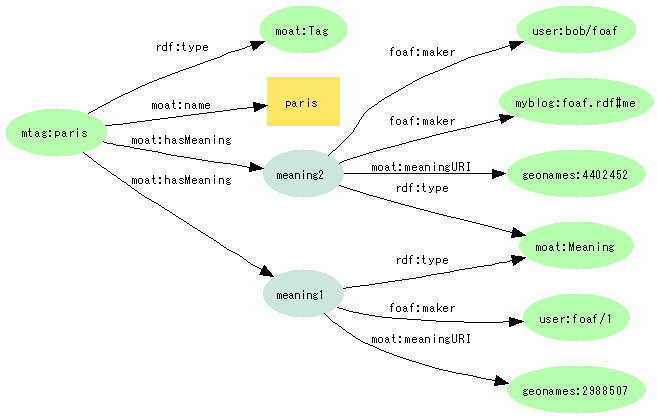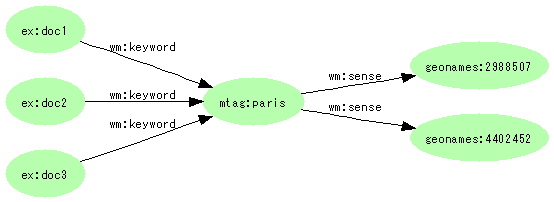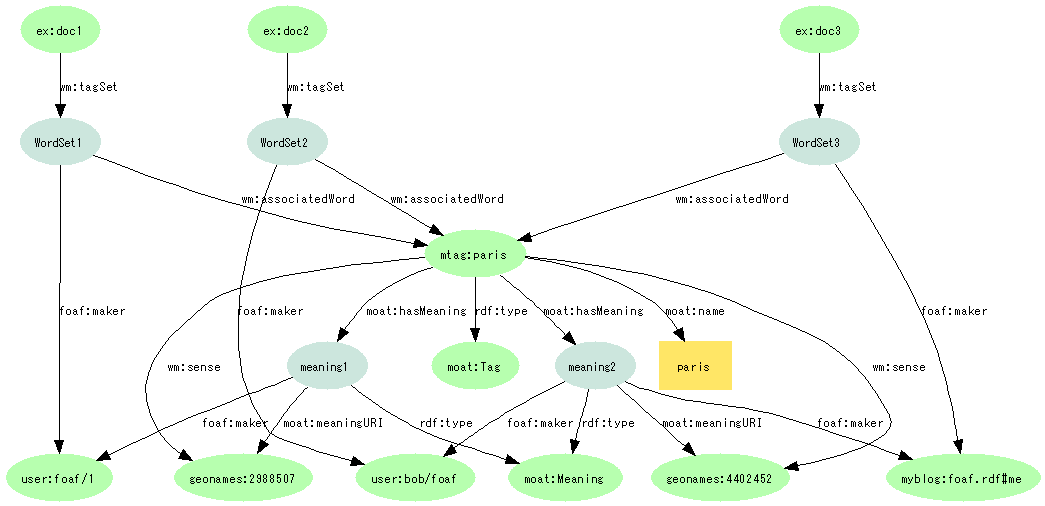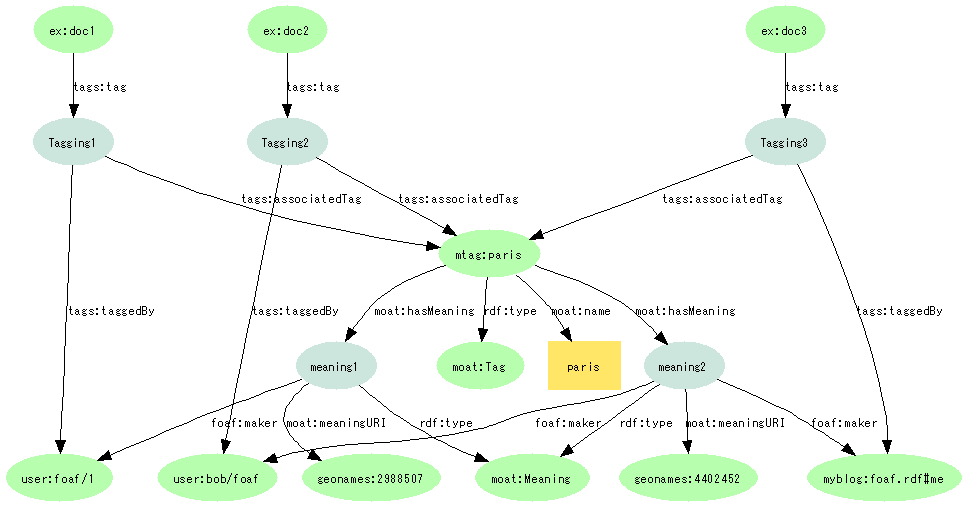Comparison of Wordmap Vcabulary and MOAT
This is a quick memo to explain the relationship between Wordmap vocabulary and MOAT (Meaning Of A Tag).
MOAT
A sample tag description example taken from MOAT project ontology page.
(例)
<moat:Tag rdf:about="http://tags.moat-project.org/tag/paris"> <moat:name><![CDATA[paris]]></moat:name> <moat:hasMeaning> <moat:Meaning> <moat:meaningURI rdf:resource="http://sws.geonames.org/2988507/"/> <foaf:maker rdf:resource="http://example.org/user/foaf/1"/> </moat:Meaning> </moat:hasMeaning> <moat:hasMeaning> <moat:Meaning> <moat:meaningURI rdf:resource="http://sws.geonames.org/4402452/"/> <foaf:maker rdf:resource="http://example.org/user/bob/foaf"/> <foaf:maker rdf:resource="http://somwhere.net/myblog/foaf.rdf#me"/> </moat:Meaning> </moat:hasMeaning> </moat:Tag>

Wordmap vocabulary
Wordmap vocabulary is a set of terms that relate keyword in a document to objects that represent 'word', and also relate these objects to Subjects (concepts etc.). It is designed to be used with GRDDL that extracts keywords (objects) from XHTML documents and generates RDF graph without human intervention. In addition to tag-meaning relation above, this vocabulary describes document-tag-meaning(subject) relationship as:
(例)
<rdf:Description rdf:about="http://tags.moat-project.org/tag/paris"> <wm:sense rdf:resource="http://sws.geonames.org/2988507"/> <wm:sense rdf:resource="http://sws.geonames.org/4402452"/> </rdf:Description> <rdf:Description rdf:about="http://example.org/doc/doc1"> <wm:keyword rdf:resource="http://tags.moat-project.org/tag/paris"/> </rdf:Description> <rdf:Description rdf:about="http://example.org/doc/doc2"> <wm:keyword rdf:resource="http://tags.moat-project.org/tag/paris"/> </rdf:Description> <rdf:Description rdf:about="http://example.org/doc/doc3"> <wm:keyword rdf:resource="http://tags.moat-project.org/tag/paris"/> </rdf:Description>

Wordmap vocabulary has properties wm:tagSet and wm:associatedWord. With these terms, the above relationship can be described as the model almost identical to Tag Ontology by Newman et al.
(例)
<rdf:Description rdf:about="http://tags.moat-project.org/tag/paris"> <wm:sense rdf:resource="http://sws.geonames.org/2988507"/> <wm:sense rdf:resource="http://sws.geonames.org/4402452"/> </rdf:Description> <rdf:Description rdf:about="http://example.org/doc/doc1"> <wm:tagSet> <wm:WordSet rdf:nodeID="Tagging1"> <wm:associatedWord rdf:resource="http://tags.moat-project.org/tag/paris"/> </wm:WordSet> </wm:tagSet> </rdf:Description> <rdf:Description rdf:about="http://example.org/doc/doc2"> <wm:tagSet> <wm:WordSet rdf:nodeID="Tagging2"> <wm:associatedWord rdf:resource="http://tags.moat-project.org/tag/paris"/> <foaf:maker rdf:resource="http://example.org/user/bob/foaf"/> </wm:WordSet> </wm:tagSet> </rdf:Description> <rdf:Description rdf:about="http://example.org/doc/doc3"> <wm:tagSet> <wm:WordSet rdf:nodeID="Tagging3"> <wm:associatedWord rdf:resource="http://tags.moat-project.org/tag/paris"/> <foaf:maker rdf:resource="http://somwhere.net/myblog/foaf.rdf#me"/> </wm:WordSet> </wm:tagSet> </rdf:Description>

MOAT + Wordmap
Combined with MOAT ontology, tag description will look like this:

This means that moat:Tag is almost equivalent to wm:Word (not used in these examples). Also, an inference rule {?x moat:hasMeaning [moat:meaningURI ?y] .} => {?x wm:sense ?y .} holds.
Tag Ontology
These relationship can be expressed with Tag Ontology and MOAT, though there is no corresponding property to wm:sense.

You might think this looks more natural if a Tagging has a Meaning, and a person is associated with Tagging, not Meaning. However, since a Tagging can have multiple associatedTag, it is not possible to establish such one-to-one mapping.



